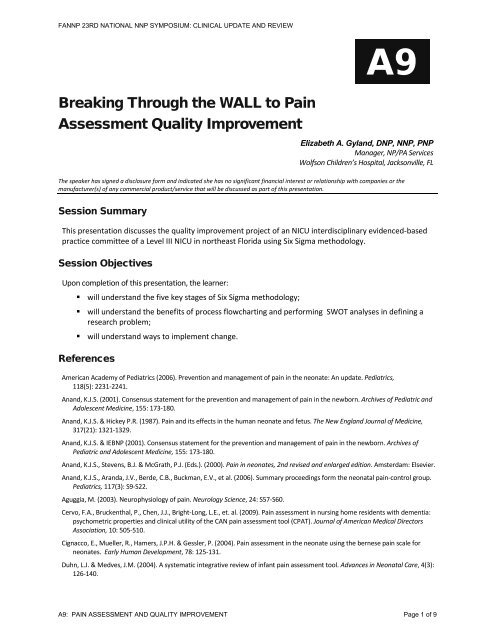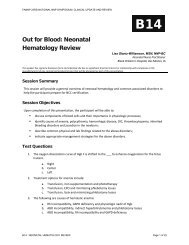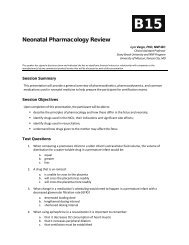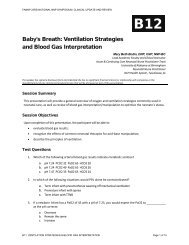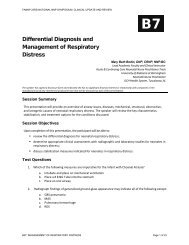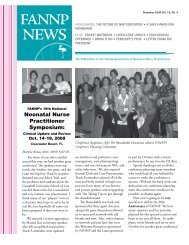Breaking Through the WALL to Pain Assessment Quality ... - FANNP
Breaking Through the WALL to Pain Assessment Quality ... - FANNP
Breaking Through the WALL to Pain Assessment Quality ... - FANNP
Create successful ePaper yourself
Turn your PDF publications into a flip-book with our unique Google optimized e-Paper software.
<strong>FANNP</strong> 23RD NATIONAL NNP SYMPOSIUM: CLINICAL UPDATE AND REVIEW<br />
A9<br />
<strong>Breaking</strong> <strong>Through</strong> <strong>the</strong> <strong>WALL</strong> <strong>to</strong> <strong>Pain</strong><br />
<strong>Assessment</strong> <strong>Quality</strong> Improvement<br />
Elizabeth A. Gyland, DNP, NNP, PNP<br />
Manager, NP/PA Services<br />
Wolfson Children’s Hospital, Jacksonville, FL<br />
The speaker has signed a disclosure form and indicated she has no significant financial interest or relationship with companies or <strong>the</strong><br />
manufacturer(s) of any commercial product/service that will be discussed as part of this presentation.<br />
Session Summary<br />
This presentation discusses <strong>the</strong> quality improvement project of an NICU interdisciplinary evidenced-based<br />
practice committee of a Level III NICU in nor<strong>the</strong>ast Florida using Six Sigma methodology.<br />
Session Objectives<br />
Upon completion of this presentation, <strong>the</strong> learner:<br />
• will understand <strong>the</strong> five key stages of Six Sigma methodology;<br />
• will understand <strong>the</strong> benefits of process flowcharting and performing SWOT analyses in defining a<br />
research problem;<br />
• will understand ways <strong>to</strong> implement change.<br />
References<br />
American Academy of Pediatrics (2006). Prevention and management of pain in <strong>the</strong> neonate: An update. Pediatrics,<br />
118(5): 2231-2241.<br />
Anand, K.J.S. (2001). Consensus statement for <strong>the</strong> prevention and management of pain in <strong>the</strong> newborn. Archives of Pediatric and<br />
Adolescent Medicine, 155: 173-180.<br />
Anand, K.J.S. & Hickey P.R. (1987). <strong>Pain</strong> and its effects in <strong>the</strong> human neonate and fetus. The New England Journal of Medicine,<br />
317(21): 1321-1329.<br />
Anand, K.J.S. & IEBNP (2001). Consensus statement for <strong>the</strong> prevention and management of pain in <strong>the</strong> newborn. Archives of<br />
Pediatric and Adolescent Medicine, 155: 173-180.<br />
Anand, K.J.S., Stevens, B.J. & McGrath, P.J. (Eds.). (2000). <strong>Pain</strong> in neonates, 2nd revised and enlarged edition. Amsterdam: Elsevier.<br />
Anand, K.J.S., Aranda, J.V., Berde, C.B., Buckman, E.V., et al. (2006). Summary proceedings form <strong>the</strong> neonatal pain-control group.<br />
Pediatrics, 117(3): S9-S22.<br />
Aguggia, M. (2003). Neurophysiology of pain. Neurology Science, 24: S57-S60.<br />
Cervo, F.A., Bruckenthal, P., Chen, J.J., Bright-Long, L.E., et. al. (2009). <strong>Pain</strong> assessment in nursing home residents with dementia:<br />
psychometric properties and clinical utility of <strong>the</strong> CAN pain assessment <strong>to</strong>ol (CPAT). Journal of American Medical Direc<strong>to</strong>rs<br />
Association, 10: 505-510.<br />
Cignacco, E., Mueller, R., Hamers, J.P.H. & Gessler, P. (2004). <strong>Pain</strong> assessment in <strong>the</strong> neonate using <strong>the</strong> bernese pain scale for<br />
neonates. Early Human Development, 78: 125-131.<br />
Duhn, L.J. & Medves, J.M. (2004). A systematic integrative review of infant pain assessment <strong>to</strong>ol. Advances in Neonatal Care, 4(3):<br />
126-140.<br />
A9: PAIN ASSESSMENT AND QUALITY IMPROVEMENT Page 1 of 9
<strong>FANNP</strong> 23RD NATIONAL NNP SYMPOSIUM: CLINICAL UPDATE AND REVIEW<br />
Evans, J., Vogelpohl, D., Bourguignon, C. & Morcott, C. (1997). <strong>Pain</strong> behaviors in LBW infants accompany some nonpainful<br />
caregiving procedures. Neonatal Network, 16(3).<br />
Fillingim, R.B. (2003). Class lecture: Introduction <strong>to</strong> pain. (8/25/03).<br />
Franck, L.S. (2002). Some pain, some gain: Reflections on <strong>the</strong> past two decades of neonatal pain research and treatment.<br />
Neonatal Network, 21(5): 37-40<br />
Hummel, P. & Puchalski, M. (2002). N-PASS: Neonatal pain, agitation, and sedation scale. Retrieved May 24, 2009 from<br />
http://www.n-pass.com<br />
Schecter, N.L., Berde, C.B. & Yaster, M. (2003). <strong>Pain</strong> in infants, children, and adolescents. An overview. In: N.L. Schecter, C.B Berde<br />
and M. Yaster, (Eds.), <strong>Pain</strong> in Infants, Children, and Adolescents (pp. 3-18). Philadelphia: Lippincott Williams & Wilkins.<br />
Simons, S.H.P., VanDijk, M., Anand, K.S., Roofthooft, D., VanLingen, R.A. & Tibboel, D. (2003). Do we still hurt newborn babies?<br />
Archives of Pediatric and Adolescent Medicine, 157: 1058-1064<br />
Spence, K., Gillies, D., Harrison, D., Johns<strong>to</strong>n, L. & Nagy, S. (2005). A reliable pain assessment <strong>to</strong>ol for clinical assessment in <strong>the</strong><br />
neonatal intensive care unit. Journal of Obstetric, Gynecologic, and Neonatal Nursing, 33(5): 80-86.<br />
Stevens, B.J. & Franck, L. (2001). <strong>Assessment</strong> and management of pain in neonates. Paediatric Drugs, 3(7): 539-558.<br />
Stevens, B, Johns<strong>to</strong>n, C, Petryshen, P. & Taddio, A. (1996). Premature infant pain profile: development and initial validation. The<br />
Clinical Journal of <strong>Pain</strong>, 12(1): 13-22.<br />
The Joint Commission: personal email communication April 14, 2009.<br />
Thoman, E. (1990). Sleeping and waking states in infancy: A functional perspective. Neuroscience and Behavior Reviews,<br />
14(1): 93-107.<br />
Walden, M. (2001). <strong>Pain</strong> assessment and management. Guideline for practice. Glenview: National Association of Neonatal Nurses.<br />
Walden, M. & Gibbins, S. (2008). <strong>Pain</strong> <strong>Assessment</strong> and Management. Guideline for practice (2nd ed.). Glenview: National<br />
Association of Neonatal Nurses.<br />
Warnock, F. & Lander, J. (2004). Foundations of knowledge about neonatal pain. Journal of <strong>Pain</strong> and Symp<strong>to</strong>m Management,<br />
27(2): 170-179.<br />
Session Outline<br />
See handout on <strong>the</strong> following pages.<br />
A9: PAIN ASSESSMENT AND QUALITY IMPROVEMENT Page 2 of 9
<strong>FANNP</strong> 23RD NATIONAL NNP SYMPOSIUM: CLINICAL UPDATE AND REVIEW<br />
<strong>Breaking</strong> <strong>Through</strong> <strong>the</strong> Wall<br />
<strong>to</strong> <strong>Pain</strong> <strong>Assessment</strong><br />
THE <strong>WALL</strong><br />
<strong>Quality</strong> Improvement<br />
Elizabeth A. Gyland, DNP, NNP, PNP<br />
Manager, WCH NP/PA Services<br />
elizabeth.gyland@bmcjax.com<br />
<strong>Pain</strong> in Infants<br />
Background Study<br />
• Inherent quality that serves as a<br />
signaling system for tissue damage as it<br />
is protective and crucial for survival<br />
(Stevens and Franck, 2001)<br />
• Simons et al documented 20,000 pain-producing<br />
procedures of a sample of 151 neonates during<br />
<strong>the</strong> first 14 days of life in a neonatal intensive<br />
care unit (NICU). This averaged 196 procedures<br />
per infant, or between 12 and 15 procedures per<br />
day and less than 35% of <strong>the</strong>se procedures were<br />
associated with some form of analgesia (Simons,<br />
van Dijk, Anand, Rofhooft, vanLingen, & Tibboel,<br />
2003).<br />
<strong>Pain</strong> <strong>Assessment</strong> and<br />
Management Guidelines for<br />
Practice, 2nd edition<br />
• According <strong>to</strong> NANN (National Association of Neonatal<br />
Nurses):<br />
– Guideline II-<strong>Pain</strong> is assessed and reassessed at<br />
regular intervals throughout <strong>the</strong> infant’s<br />
hospitalization<br />
– Guideline V-<strong>Pain</strong> assessment and management<br />
practices should be documented in a manner that<br />
facilitates regular reassessment and follow-up<br />
intervention<br />
¯ (Walden & Gibbins, 2008)<br />
<strong>Assessment</strong> <strong>to</strong> Management<br />
• <strong>Pain</strong> assessment is an essential<br />
component of pain management (Walden<br />
& Gibbins, 2008)<br />
• Reliable and valid pain assessment is <strong>the</strong><br />
CORNERSTONE <strong>to</strong> effective pain<br />
management!<br />
A9: PAIN ASSESSMENT AND QUALITY IMPROVEMENT Page 3 of 9
<strong>FANNP</strong> 23RD NATIONAL NNP SYMPOSIUM: CLINICAL UPDATE AND REVIEW<br />
Goal<br />
How?<br />
• To effectively assess and manage<br />
pos<strong>to</strong>perative, procedural, and diseaserelated<br />
pain in hospitalized infants<br />
(Walden, 2001; Walden & Gibbins, 2008)<br />
• There is currently NO GOLD STANDARD<br />
BIOLOGICAL MEASURE FOR INFANT<br />
PAIN!<br />
The Focus for <strong>Pain</strong><br />
<strong>Assessment</strong><br />
• Physiological indica<strong>to</strong>rs of pain (VS, O2<br />
sats, ICP, MAP, HR variability, skin color<br />
• Biochemical indica<strong>to</strong>rs of pain (cortisol,<br />
epinephrine, norepinephrine, glucagon,<br />
aldosterone, insulin)<br />
• Behavioral indica<strong>to</strong>rs of pain (cry, muscle<br />
<strong>to</strong>ne, behavioral state changes, body<br />
movements, facial expression)<br />
• (Warnock & Lander, 2004)<br />
Clinical Question<br />
• For an infant in a level III NICU in<br />
Nor<strong>the</strong>ast Florida, is <strong>the</strong> current pain<br />
assessment <strong>to</strong>ol, <strong>the</strong> Neonatal Infant<br />
<strong>Pain</strong> Score (NIPS), <strong>the</strong> most appropriate<br />
and evidence-based infant pain<br />
assessment <strong>to</strong>ol when compared <strong>to</strong> o<strong>the</strong>r<br />
<strong>to</strong>ols recommended by <strong>the</strong> National<br />
Association of Neonatal Nurses?<br />
Framework<br />
• Six Sigma methodology uses 5 key<br />
stages:<br />
– Define<br />
– Measure<br />
– Analyze<br />
– Improve<br />
– Control<br />
A9: PAIN ASSESSMENT AND QUALITY IMPROVEMENT Page 4 of 9
<strong>FANNP</strong> 23RD NATIONAL NNP SYMPOSIUM: CLINICAL UPDATE AND REVIEW<br />
Define Phase<br />
Committee Survey<br />
• Objective: To identify and/or validate <strong>the</strong><br />
improvement opportunity<br />
• Activities:<br />
– Committee survey on pain assessment in our<br />
NICU<br />
– PowerPoint presentation of his<strong>to</strong>ry of pain and<br />
<strong>the</strong> development of <strong>the</strong> pain pathways in <strong>the</strong><br />
infant<br />
– Development of an overall <strong>the</strong>me aim<br />
statement for <strong>the</strong> project<br />
• Do infants experience pain?<br />
• How do you know that an infant is experiencing pain? (List<br />
fac<strong>to</strong>rs that you use <strong>to</strong> determine if an infant is in pain)<br />
• At what point(s) during <strong>the</strong> NICU stay do you witness an infant<br />
experiencing pain? (List specifically)<br />
• What pain scale is currently used in our NICU?<br />
• What are <strong>the</strong> individual parameters of <strong>the</strong> NICU pain scale?<br />
• How does one interpret <strong>the</strong> <strong>to</strong>tal pain score?<br />
• How often do you do a pain assessment in a shift?<br />
• What guides how many pain assessments that you do in a shift?<br />
• Do you consistently report an abnormal pain score <strong>to</strong> a Neo NNP<br />
or PA-C?<br />
• What are your results of reporting an abnormal pain score?<br />
• Do you currently teach our NICU parent(s) or caregivers<br />
about pain?<br />
Results<br />
Theme Aim Statement<br />
• 19 surveys completed<br />
• All agreed infants experience pain<br />
• Both behavioral and physiologic signs were known by<br />
nursing<br />
• Unders<strong>to</strong>od when an infant may experience pain<br />
• 74% knew name of current pain scale used<br />
• No consistency in knowledge of parameters of pain scale<br />
• Extreme variability in how <strong>to</strong> interpret pain score<br />
• <strong>Pain</strong> assessments only done once per shift<br />
• 79% of RNs consistently report an abnormal pain score<br />
• Extreme variability outcomes of reporting abnormal<br />
score<br />
• No consistency in parent teaching<br />
• We aim <strong>to</strong> improve <strong>the</strong> accuracy, functionality,<br />
and consistency of pain assessment of <strong>the</strong><br />
neonate.<br />
• The process will end with a recommendation of a<br />
pain assessment <strong>to</strong>ol <strong>to</strong> <strong>the</strong> NICU Steering<br />
Committee.<br />
• It is important <strong>to</strong> work on this now because we<br />
will <strong>the</strong>n be one step closer <strong>to</strong> providing<br />
appropriate pain management for <strong>the</strong> critically<br />
ill neonate.<br />
Measure Phase<br />
• Objective: Map process<br />
• Activities:<br />
– Workflow analysis of <strong>the</strong> current<br />
process for pain assessment in our<br />
NICU<br />
– SWOT analysis of current process<br />
Current <strong>Pain</strong> <strong>Assessment</strong><br />
Process Flowchart<br />
CURRENT PAIN ASSESSMENT FLOWCHART<br />
Score Under 5 Score – 5-10<br />
Non-pharmacologic<br />
intervention<br />
Nonpharmacologic<br />
and give prn<br />
pain meds.<br />
Perform a <strong>Pain</strong> <strong>Assessment</strong> Based on<br />
Practice and <strong>Assessment</strong> of <strong>Pain</strong> Cues<br />
Assign <strong>Pain</strong> Score 0 - 10<br />
Reassess pain score<br />
after 15-30 minutes<br />
depending on<br />
treatment modality.<br />
If no existing prn<br />
order or intervention<br />
is ineffective, inform<br />
extender/<br />
neona<strong>to</strong>logist of<br />
score.<br />
If no order received, notify<br />
different extender/<br />
neona<strong>to</strong>logist.<br />
Continue non pharmacologic<br />
interventions<br />
Continue <strong>to</strong> document<br />
pain score.<br />
Write pie note -include<br />
no orders received,<br />
extender/neona<strong>to</strong>logist<br />
notified.<br />
If reassessment<br />
score still >5,<br />
repeat process.<br />
A9: PAIN ASSESSMENT AND QUALITY IMPROVEMENT Page 5 of 9
<strong>FANNP</strong> 23RD NATIONAL NNP SYMPOSIUM: CLINICAL UPDATE AND REVIEW<br />
SWOT Analysis of Current<br />
Process<br />
Analyze Phase<br />
Strengths<br />
Nurses care<br />
Good assessment skills<br />
Realization of <strong>the</strong> importance of pain<br />
assessment<br />
Patient advocates<br />
Some physician are proponents of pain<br />
management<br />
A IR audits reveal high scores<br />
Dedicated NICU pharmacist<br />
O pportunities<br />
T JC initiative for pain<br />
assessment/management<br />
Research best practice for pain assessment<br />
E m pow er N ICU interdisciplinary team<br />
Develop a standardized process for pain<br />
assessment<br />
Performance improvement<br />
Improve parent satisfaction scores<br />
T each parents developm ental care<br />
Increase reporting of abnormal pain scores<br />
Weaknesses<br />
Current pain assessment <strong>to</strong>ol<br />
Lack of pain management pro<strong>to</strong>col<br />
S om e physicians not engaged in pain<br />
management<br />
G eneral lack of knowledge of infant physical<br />
cues of pain<br />
Fear of infant addiction <strong>to</strong> pain medication<br />
Lack of knowledge of specific pain<br />
medications and <strong>the</strong> pharmocokinetics of<br />
pain medications<br />
Threats<br />
Lack of buy-in of staff, physicians, parents<br />
Possible increase of tim e infant on a<br />
ventila<strong>to</strong>r<br />
Perception of addiction<br />
Nurses not taking time <strong>to</strong> correctly score<br />
• Objective: Identify specific problem(s)<br />
• Activities:<br />
– Review <strong>Pain</strong> <strong>Assessment</strong> and Management. Guideline<br />
for Practice. 2 nd edition (NANN, 2008)<br />
– Group assignments <strong>to</strong> research <strong>the</strong> literature for<br />
information from our local, national, and international<br />
governing bodies and recommended infant pain<br />
assessment <strong>to</strong>ols<br />
– Presentation by each group of info, including SWOT<br />
analysis<br />
– Development of matrix of all SWOT analyses<br />
– Review of matrix by committee<br />
Guidelines Reviewed<br />
• The Joint Commission<br />
• The International Evidence-Based Group<br />
for Neonatal <strong>Pain</strong><br />
• American Academy of Pediatrics<br />
i<br />
• WCH Policy regarding pain assessment<br />
• 2008 NANN Guidelines<br />
Infant <strong>Pain</strong> <strong>Assessment</strong><br />
Tools<br />
• Neonatal, <strong>Pain</strong>, Agitation, and Sedation Scale<br />
(N-PASS)<br />
• <strong>Pain</strong> <strong>Assessment</strong> Tool (PAT)<br />
• Scale for Use in Newborns (SUN)<br />
• Bernese <strong>Pain</strong> Scale for Neonates (BPSN)<br />
• Premature Infant <strong>Pain</strong> Profile (PIPP)<br />
• CRIES: Neonatal Pos<strong>to</strong>perative <strong>Pain</strong> <strong>Assessment</strong><br />
• Neonatal Infant <strong>Pain</strong> Scale (NIPS)<br />
Weaknesses of Current<br />
Tool-NIPS<br />
• The pain score is NOT adjusted for <strong>the</strong><br />
gestational age of <strong>the</strong> infant<br />
• It does not address sedation<br />
• Its primary use is for procedural pain<br />
only<br />
• THE INTERPRETATION OF THE SCORE<br />
IS SUBJECTIVE!<br />
Improve Phase<br />
• Objective: Evaluate and select solution<br />
• Activities:<br />
– Committee recommended fur<strong>the</strong>r<br />
review of N-PASS and PIPP <strong>to</strong>ols<br />
– Research pro<strong>to</strong>col for comparison of<br />
ease of use of N-PASS and PIPP<br />
received IRC approval and NICU<br />
Steering Committee approval<br />
A9: PAIN ASSESSMENT AND QUALITY IMPROVEMENT Page 6 of 9
<strong>FANNP</strong> 23RD NATIONAL NNP SYMPOSIUM: CLINICAL UPDATE AND REVIEW<br />
Comparison Study<br />
PIPP<br />
• Purpose: To compare ease of use of <strong>the</strong> PIPP and<br />
<strong>the</strong> N-PASS<br />
• Sample: 32 NICU RNs, not currently working on<br />
<strong>the</strong> project<br />
• Research Plan:<br />
– Each participant was presented<br />
information regarding each pain<br />
assessment <strong>to</strong>ol, <strong>the</strong>n assign pain scores<br />
for 2 case studies<br />
– Completed questionnaire rating ease of<br />
use for each <strong>to</strong>ol<br />
N-PASS<br />
N-PASS vs PIPP<br />
Please rate each statement below on a scale of:<br />
1=strongly agree<br />
2=somewhat agree<br />
3=undecided<br />
4=somewhat disagree<br />
5=strongly disagree<br />
• This pain scale was easy <strong>to</strong> use.<br />
• This pain scale was not time consuming.<br />
• This pain scale is appropriate <strong>to</strong> assess pain.<br />
• This pain scale is able <strong>to</strong> differentiate <strong>the</strong> level of<br />
pain<br />
Results<br />
Final Question<br />
Question Mean PIPP Mean N-PASS Test statistic<br />
1 1.656 1.969 t(62)=1.34, p=0.1861<br />
2 1.656 2.094 t(62)=1.65, p=0.1047<br />
3 1.406 1.500 t(62)=0.52, p=0.6019<br />
4 1.344 1.677 t(61)=1.43, p=0.1566<br />
5 1.563 1.452 t(61)=-0.59,p=0.5552<br />
• Now that you have sampled using both<br />
<strong>to</strong>ols, which <strong>to</strong>ol would you like <strong>to</strong> see<br />
used in our NICU?<br />
The results are quite similar<br />
Statistically, nei<strong>the</strong>r instrument is significantly different<br />
All <strong>the</strong> means are between 1 and 2<br />
Statistically, <strong>the</strong>re would be no large difference if we continued <strong>to</strong> collect data. (Question presented <strong>to</strong> statistician)<br />
A9: PAIN ASSESSMENT AND QUALITY IMPROVEMENT Page 7 of 9
<strong>FANNP</strong> 23RD NATIONAL NNP SYMPOSIUM: CLINICAL UPDATE AND REVIEW<br />
Final Decision<br />
Control Phase<br />
• The RNs preferred <strong>the</strong> N-PASS<br />
– calculate both a pain AND a sedation score<br />
– pulls in<strong>to</strong> play more assessment skills,<br />
<strong>the</strong>refore giving g a more comprehensive<br />
picture of <strong>the</strong> infant EVEN THOUGH <strong>the</strong>y<br />
stated it may take MORE time <strong>to</strong> use, require<br />
MORE in-depth training, and have a GREATER<br />
learning curve<br />
• Objective: Implement change<br />
• Activities:<br />
– Presentation of recommendation <strong>to</strong><br />
NICU Steering Committee for approval<br />
– Development of eLearning module for<br />
staff training<br />
– Staff training<br />
– Audits on use of <strong>to</strong>ol after Go-Live<br />
– Development of <strong>to</strong>ol for EMR use<br />
eLearning Module<br />
Go-Live for N-PASS<br />
• Approval for change of <strong>to</strong>ol on current<br />
flowsheet on down<strong>to</strong>wn campus<br />
• Go-Live was November 16, 2010 for Level<br />
III NICU on down<strong>to</strong>wn campus<br />
• Began working with IS department for<br />
EMR development<br />
• Audits:<br />
– Are pain assessments being done<br />
with every set of vital signs?<br />
– Does overall scoring seem appropriate?<br />
Fur<strong>the</strong>r Work<br />
• Continued audit<br />
– For those with N-PASS scores >3 during FY<br />
2012 in NICU, average 66.4% received<br />
pharmacologic intervention<br />
• Re-inservicing re: calculation of sedation score<br />
• Introduce staff <strong>to</strong> N-PASS <strong>to</strong>ol in <strong>the</strong> EMR<br />
• Overall hospital policy change for pain<br />
assessment <strong>to</strong> be considered 5 th vital sign<br />
– Audit NICU FY 2012- 93.2% completed<br />
• Compare cost of pain/sedation meds used in<br />
<strong>the</strong> NICU before implementation with after<br />
implementation of N-PASS<br />
A9: PAIN ASSESSMENT AND QUALITY IMPROVEMENT Page 8 of 9
<strong>FANNP</strong> 23RD NATIONAL NNP SYMPOSIUM: CLINICAL UPDATE AND REVIEW<br />
A9: PAIN ASSESSMENT AND QUALITY IMPROVEMENT Page 9 of 9


